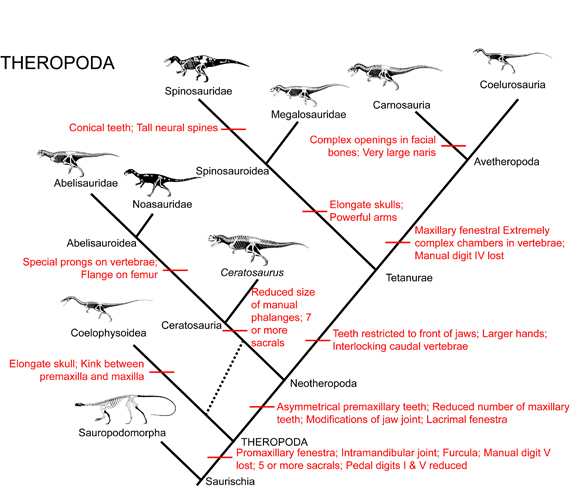Became the largest terrestrial carnivores of all time, but began at about 1 m long,
and even by end of Late Triassic were dwarfed by rauisuchians
Some taxa from the Ischigualasto Fm. (Eoraptor and Herrerasauridae) have
been considered theropods. Like theropods, they were carnivorous. However, they lack features
shared by Sauropodomorpha and Theropoda, and so are most likely non-eusaurischian saurischians.

True theropods share many derived characters:
- An intramandibular joint between the dentary and postdentary bones
- Absorbs the stresses of struggling prey
- Also found in eutheropods
- Promaxillary fenestra (an extra opening in the maxilla between the naris and
the antorbital fenestra)
- Five or more sacrals
- Furcula (clavicles fused into wishbone)
- Manual digit V lost: hand has only four fingers
- Pedal digits I and V reduced, so foot is functionally three-toed
Theropods include three main branches: Coelophysoidea, Ceratosauria,
and Tetanurae. Coelophysoids were once considered part of Ceratosauria, but new
detailed anatomy suggests that ceratosaurs are closer to tetanurines (in the group Neotheropoda).
Coelophysoidea:
- Once considered part of Ceratosauria, but new evidence suggests they are the sister taxon
to ceratosaurs plus tetanurines
- Generally relatively slender and long-necked
- Elongate skulls
- Characterized by kink between the premaxilla and maxilla, probably for dealing
with small struggling prey
- Appear in Late Triassic (first major theropod radiation), dominant predators of Early
Jurassic. 5 m long Elaphrosaurus of the Late Jurassic might be a late-surviving coelophysoid, but
is more likely a gracile ceratosaur.
- Best known coelophysoids are 3 m long Coelophysis of the Late Triassic of the American
Southwest; 3 m long Megapnosaurus (formerly Syntarsus) of southern Africa,
and 6 m or more Dilophosaurus of the Early Jurassic of the American
Southwest (and possibly China).
Neotheropoda (ceratosaurs plus tetanurines) appears to be a clade united by several features,
such as asymmetrical premaxillary teeth (not cone-shaped as in more primitive forms),
fewer maxillary teeth than coelophysoids, modifications of the jaw joint, and a fenestra
in the lacrimal leading to hollow chambers.
Ceratosauria (were called "Neoceratosauria" when coelophysoids were included in
Ceratosauria)
- Characterized by seven or more sacrals, tall deep skulls with big
infratemporal fenestrae, and reduced manual phalanges
- Best known from the Late Jurassic Ceratosaurus of the western U.S. (and
possibly Africa) and the Abelisauroidea of the Cretaceous of the southern continents
- Abelisauroids share special prongs on their vertebrae and a crest or flange on the lower
part of the femur, as well as many other features. Abelisauroids contain the slender Noasauridae and
the more heavily-built, stumpy-armed Abelisauridae
The remaining neotheropods form Tetanurae ("stiff tails"). Tetanurines are
characterized by:
- Teeth restricted to front of jaws in front of orbit
- Larger hands for clutching prey
- Interlocking caudal vertebrae for counterbalance while running
Tetanurines include Spinosauroidea and Avetheropoda.
Spinosauriods contain the primitive Megalosauridae (including Megalosaurus)
and the highly specialized Spinosauridae.
Spinosaurids are characterized by:
- Long crocodile-like snouts filled with big, conical teeth
- In some taxa, very tall neural spines making a big sail
- May have been like the modern Nile Crocodile, eating both large fish and big land
animals
- Found in the Cretaceous
- Some were very large: Spinosaurus is arguably the largest known theropod
The advanced tetanurines form the clade Avetheropoda ("bird theropods").
Avetheropods are characterized by:
- Maxillary fenestra (an extra opening between the antorbital and promaxillary
fenestrae)
- More complex air chambers in their vertebrae, indicating a more advanced air sac
system
- Greatly reduced or lost manual digit IV (present in primitive forms, but most
avetheropods have only three fingers, namely I-III)
Avetheropoda is divided into two clades, Coelurosauria (subject of the
next lecture) and Carnosauria.
Carnosaurs:
- The dominent predators from the Middle Jurassic until the beginning of the Late Cretaceous
- Most of them were large; in fact, the largest known theropods are carnosaurs
- Characterized by:
- Enlarged nares
- Extra openings in snout
- Best known from Allosaurus of the Late Jurassic of western North America
and Europe (and maybe Africa) and Mapusaurus and Giganotosaurus
(among the largest known theropods) of the earliest Late Cretaceous of Argentina
- In the Late Cretaceous carnosaurs are replaced by abelisauroid ceratosaurs in the
southern continents and Europe, and by tyrannosauroids in Asia and North America
To Next Lecture.
To Previous Lecture.
To Syllabus.
Last modified: 14 July 2006

